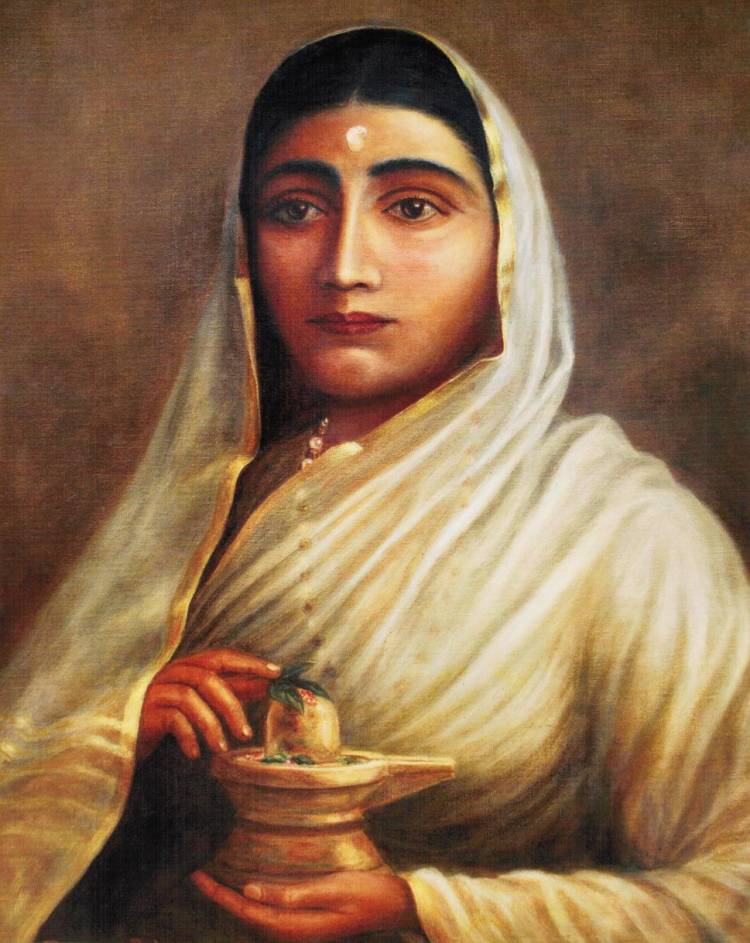[GHHF] Ahilyabai Holkar – Celebrated 300 Birth Anniversary of Queen of Mawar, Builder of Hindu Temples, and Protector of Dharma.
 “She led by example, reformed without force, and ruled with spiritual strength.” Dr. S Radhakrishna
“She led by example, reformed without force, and ruled with spiritual strength.” Dr. S Radhakrishna
Ahilyabai Holkar was born on 31 May 1725 in the village of Chaundi, located in present-day Ahilyanagar (formerly Ahmednagar), Maharashtra. Her father, Mankoji Sindhia, was a local chieftain who took the rare step of educating his daughter, teaching her to read and write at a time when girls were often denied such opportunities.
Ahilyabai married Khanderao Holkat at the age of eight. Her life took a turn when Malhar Rao Holkar spotted her at a temple feeding the poor and was impressed by her character. Then, He arranged her marriage to his son in 1733.
At the age of 20, she was blessed with a son, Male Rao who died at the age of 19. In 754, her husband was killed in a battle of Kumber, making her a widow at the age of 29.
Following the death of her husband and her only son, she ascended the throne of Indore in 1767. She ruled the kingdom for thirty years protecting dharma, building and restoring hundreds of Hindu Temples and enforcing the law strictly following the prevailing justice system.
Ahilyabai was a courageous warrior and a tremendous archer. She used to fight on the back of the elephant. He always kept his territory safe for many years with Bhils and Gonds who were always ready to attack.
Ahilyabai held public audiences every day to help address the grievances of her people. She was always available to anyone who needed her ear.
She encouraged all businesspeople within her realm and her kingdom to do their best for the people. During her reign, the merchants produced their most elegant clothes and trade flourished to no end. No more was the farmer a mere victim of oppression but a self-sufficient man in his own right.
Anne Besant wrote that “Far and wide the roads were planted with shady trees, and wells were made, and resthouses for travelers. The poor, the homeless, the orphaned were all helped according to their needs. The Bhil’s, who had long been the torment of all caravans, were routed from their mountain fastnesses and persuaded to settle down as honest farmers. Hindu and Musalman alike revered the famous Queen and prayed for her long life.”
Ahilyabai became a Championed the cause of Hindu Temples.
Among all her achievements, reconstruction of temples destroyed by Islamic invaders or rule From Dwarka to Gaya and Gangotri to Rameshwaram, to building ghats alongside almost all rivers, and initiating charities to facilitate pilgrimages, everything at present form is the result of Ahilyabai’s diligent determination to restore the Bharatvarsha that was raging in vulnerable forgetfulness. The reconstruction of Somnath Jyotirlinga in Kathiawad, Gujarat and Kashi Vishwanath Jyotirlinga in Benaras (Varanasi), which holds epitomizing prominence of crores of Hindus, alone reflects the dedication of this feisty queen.rs and refurbishment of holy sites counts as the most pivotal service to the sustenance of Bharat.
She restored 12 Jyotirlingas, contributed to the restoration of temples at Srinagar, Haridwar, Kedarnath, Badrinath, Rishikesh, Prayagraj, Varanasi, Naimisharanya, Rameswaram, Somnath, Nashik, Omkareshwar, Mahabaleshwar, Pune, Indore, Srisailam, Udupi, Gokarna, and many more. Every holy pilgrimage site in India bears her contribution in some form.
Various other Jyotirlinga (ah) destroyed by Islamists were built or rebuilt by Maharani Ahilyabai. For instance, Grishneshwar Jyotirlinga, Aurangabad, was reconstructed by the queen; Aundha Nagnath Jyotirlinga (8th Jyotirlinga in Hongli district of Maharashtra) destroyed by Aurangzeb, was renovated by Ahilyabai. The Bhimashankar Jyotirlinga Temple was repaired, Tarakeshwara Temple was constructed, and the Kushavarta Kund was built at Triyambakeshwar Jyotirlinga Temple at Nasik in 1750.
Hanuman Temple at Rameshwaram, Vishnupad Temple in Gaya, Shri Vaidyanath Temple, Shri Ram Temple and Vishweshwar Temple in Nasik, Temples and Dharmashalas in Omkareshwar, hundreds of temples in Maheshwar (where she lived after her son’s demise), Ramchandra Temple in Puri, are all the result of Ahilyabai’s volition.
Justice and Compassion
Ahilyabai never issued capital punishment. Instead, she took a personal oath from prisoners and released those who promised to reform. Many such individuals adopted honest lives, and her generosity yielded positive results. When presiding over court sessions, she always held a Shivling made of clay in her hands—a symbol of her devotion.
In her honor, the Government of India issued commemorative stamps in 1966. Rani Ahilyabai Holkar is the only public figure to be conferred the title of ‘Devi’.
She was a brave warrior and an excellent archer, leading her army multiple times to protect her kingdom.
She deeply respected art, music, literature, sculpture, and poetry, and her court was always open to artists.
Her capital was renowned for its craftsmen, sculptors, and artists, who were well-compensated and highly regarded.
The central government on Thursday announced the release of a commemorative Rs 300 coin to mark the 300th birth anniversary of Maharani Ahilyabai Holkar.
The announcement comes as part of a nationwide celebration honouring Holkar, with events being organised by the Centre, BJP, RSS, and various other institutions across the nation.

















 Urgent support needed for Bangladesh Hindus
Urgent support needed for Bangladesh Hindus 







